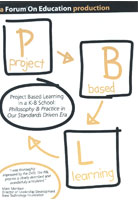
Project Based Learning in a K-8 School: Philosophy & Practice in Our Standards Driven Era 2008
Distributed by Elephant Rock Productions, PO Box 6226, Bloomington, IN 47407
Produced by The Forum on Education, Indiana University) and Elephant Rock Productions (ERP, Inc); Leonard Burrello, Jotham Burrello
Director n/a
DVD, color, 146 min. on 2 discs
College - Adult
Education
Date Entered: 07/31/2009
Reviewed by Carolyn Walden, Mervyn H. Sterne Library, University of Alabama at BirminghamThis film provides an introduction to a learning method, known as Project Based Learning, by illustrating the concepts that occur in the classrooms at Swift House, a “multi-aged class of 87 learners” and one of the “houses” of the 10 schools that comprise Williston Central School in Vermont. Project based learning is based on “authentic assessment embedded in the learning process” and is an “innovative alternative” that allows schools to comply with the federal No Child Left Behind Act.
The instructive documentary is divided into 10 sections with each section introduced by graphics and lively rhythmic music appropriate for an educational documentary. The sections move from the philosophy of learning and standards to authentic learning, intervention, and progress monitoring with portfolios. The “Levels of Excellence Rubric” help faculty understand what is required to move from the novice teacher through the highest level of learning as a scholar while the presentation of peer assisted learning and the pyramid of intervention captures interest.
The film places emphasis on students who are struggling and demonstrates how project based learning codifies what practices succeed. The student portfolios place you in touch with the work of the student. The film probes, questions, and looks for solutions as the viewer receives practical, solid information to help translate the concept into practice. In addition, it is inspiring to observe that the children as adults are proving the methods are successful. Although the intent of the film is to document the success of the Swift House, the challenge for educators is to conceptualize this method in school systems in larger cities and in urban schools confronted with financial and family infrastructure issues. What is encouraging is that the positive, masterful presentation projects an attitude that the method can work in even the most challenging situations.
There is a supplementary DVD entitled Swift House Archive circa 1994 featuring the student voices and discussions of the programs. It is an archive of information on the application of the concepts of project based learning with a review of the practices the school has followed over the last 16 years. Recommended for collections with comprehensive holdings in education.